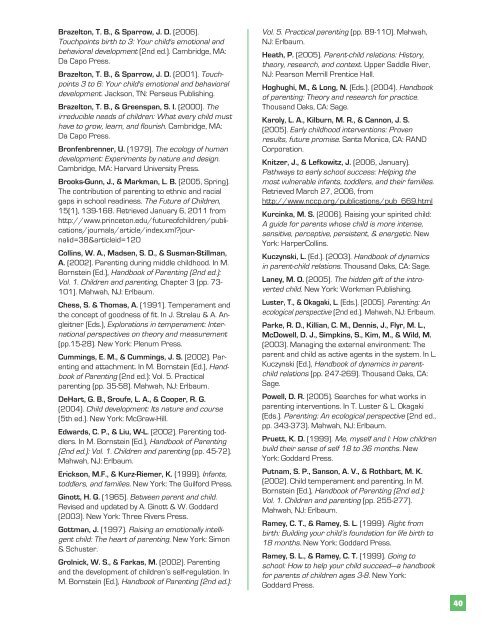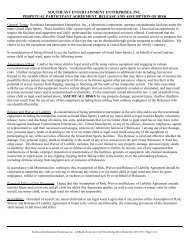Parent Education Core Curriculum Framework 2011.pdf - mnafee
Parent Education Core Curriculum Framework 2011.pdf - mnafee
Parent Education Core Curriculum Framework 2011.pdf - mnafee
Create successful ePaper yourself
Turn your PDF publications into a flip-book with our unique Google optimized e-Paper software.
Brazelton, T. B., & Sparrow, J. D. (2006).<br />
Touchpoints birth to 3: Your child's emotional and<br />
behavioral development (2nd ed.). Cambridge, MA:<br />
Da Capo Press.<br />
Brazelton, T. B., & Sparrow, J. D. (2001). Touchpoints<br />
3 to 6: Your child's emotional and behavioral<br />
development. Jackson, TN: Perseus Publishing.<br />
Brazelton, T. B., & Greenspan, S. I. (2000). The<br />
irreducible needs of children: What every child must<br />
have to grow, learn, and flourish. Cambridge, MA:<br />
Da Capo Press.<br />
Bronfenbrenner, U. (1979). The ecology of human<br />
development: Experiments by nature and design.<br />
Cambridge, MA: Harvard University Press.<br />
Brooks-Gunn, J., & Markman, L. B. (2005, Spring).<br />
The contribution of parenting to ethnic and racial<br />
gaps in school readiness. The Future of Children,<br />
15(1), 139-168. Retrieved January 6, 2011 from<br />
http://www.princeton.edu/futureofchildren/publications/journals/article/index.xml?journalid=38&articleid=120<br />
Collins, W. A., Madsen, S. D., & Susman-Stillman,<br />
A. (2002). <strong>Parent</strong>ing during middle childhood. In M.<br />
Bornstein (Ed.), Handbook of <strong>Parent</strong>ing (2nd ed.):<br />
Vol. 1. Children and parenting, Chapter 3 (pp. 73-<br />
101). Mahwah, NJ: Erlbaum.<br />
Chess, S. & Thomas, A. (1991). Temperament and<br />
the concept of goodness of fit. In J. Strelau & A. Angleitner<br />
(Eds.), Explorations in temperament: International<br />
perspectives on theory and measurement<br />
(pp.15-28). New York: Plenum Press.<br />
Cummings, E. M., & Cummings, J. S. (2002). <strong>Parent</strong>ing<br />
and attachment. In M. Bornstein (Ed.), Handbook<br />
of <strong>Parent</strong>ing (2nd ed.): Vol. 5. Practical<br />
parenting (pp. 35-58). Mahwah, NJ: Erlbaum.<br />
DeHart, G. B., Sroufe, L. A., & Cooper, R. G.<br />
(2004). Child development: Its nature and course<br />
(5th ed.). New York: McGraw-Hill.<br />
Edwards, C. P., & Liu, W-L. (2002). <strong>Parent</strong>ing toddlers.<br />
In M. Bornstein (Ed.), Handbook of <strong>Parent</strong>ing<br />
(2nd ed.): Vol. 1. Children and parenting (pp. 45-72).<br />
Mahwah, NJ: Erlbaum.<br />
Erickson, M.F., & Kurz-Riemer, K. (1999). Infants,<br />
toddlers, and families. New York: The Guilford Press.<br />
Ginott, H. G. (1965). Between parent and child.<br />
Revised and updated by A. Ginott & W. Goddard<br />
(2003). New York: Three Rivers Press.<br />
Gottman, J. (1997). Raising an emotionally intelligent<br />
child: The heart of parenting. New York: Simon<br />
& Schuster.<br />
Grolnick, W. S., & Farkas, M. (2002). <strong>Parent</strong>ing<br />
and the development of children’s self-regulation. In<br />
M. Bornstein (Ed.), Handbook of <strong>Parent</strong>ing (2nd ed.):<br />
Vol. 5. Practical parenting (pp. 89-110). Mahwah,<br />
NJ: Erlbaum.<br />
Heath, P. (2005). <strong>Parent</strong>-child relations: History,<br />
theory, research, and context. Upper Saddle River,<br />
NJ: Pearson Merrill Prentice Hall.<br />
Hoghughi, M., & Long, N. (Eds.). (2004). Handbook<br />
of parenting: Theory and research for practice.<br />
Thousand Oaks, CA: Sage.<br />
Karoly, L. A., Kilburn, M. R., & Cannon, J. S.<br />
(2005). Early childhood interventions: Proven<br />
results, future promise. Santa Monica, CA: RAND<br />
Corporation.<br />
Knitzer, J., & Lefkowitz, J. (2006, January).<br />
Pathways to early school success: Helping the<br />
most vulnerable infants, toddlers, and their families.<br />
Retrieved March 27, 2006, from<br />
http://www.nccp.org/publications/pub_669.html<br />
Kurcinka, M. S. (2006). Raising your spirited child:<br />
A guide for parents whose child is more intense,<br />
sensitive, perceptive, persistent, & energetic. New<br />
York: HarperCollins.<br />
Kuczynski, L. (Ed.). (2003). Handbook of dynamics<br />
in parent-child relations. Thousand Oaks, CA: Sage.<br />
Laney, M. O. (2005). The hidden gift of the introverted<br />
child. New York: Workman Publishing.<br />
Luster, T., & Okagaki, L. (Eds.). [2005]. <strong>Parent</strong>ing: An<br />
ecological perspective (2nd ed.). Mahwah, NJ: Erlbaum.<br />
Parke, R. D., Killian, C. M., Dennis, J., Flyr, M. L.,<br />
McDowell, D. J., Simpkins, S., Kim, M., & Wild, M.<br />
(2003). Managing the external environment: The<br />
parent and child as active agents in the system. In L.<br />
Kuczynski (Ed.), Handbook of dynamics in parentchild<br />
relations (pp. 247-269). Thousand Oaks, CA:<br />
Sage.<br />
Powell, D. R. (2005). Searches for what works in<br />
parenting interventions. In T. Luster & L. Okagaki<br />
(Eds.). <strong>Parent</strong>ing: An ecological perspective (2nd ed.,<br />
pp. 343-373). Mahwah, NJ: Erlbaum.<br />
Pruett, K. D. (1999). Me, myself and I: How children<br />
build their sense of self 18 to 36 months. New<br />
York: Goddard Press.<br />
Putnam, S. P., Sanson, A. V., & Rothbart, M. K.<br />
(2002). Child temperament and parenting. In M.<br />
Bornstein (Ed.), Handbook of <strong>Parent</strong>ing (2nd ed.):<br />
Vol. 1. Children and parenting (pp. 255-277).<br />
Mahwah, NJ: Erlbaum.<br />
Ramey, C. T., & Ramey, S. L. (1999). Right from<br />
birth: Building your child’s foundation for life birth to<br />
18 months. New York: Goddard Press.<br />
Ramey, S. L., & Ramey, C. T. (1999). Going to<br />
school: How to help your child succeed—a handbook<br />
for parents of children ages 3-8. New York:<br />
Goddard Press.<br />
40





